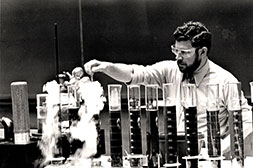

Demonstrations in Volume 1
1. THERMOCHEMISTRY
George L. Gilbert, Lloyd G. Williams, Bassam Z. Shakhashiri, Glen E. Dirreen, and Frederick H. Juergens
- 1.1 Evaporation as an Endothermic Process
- 1.2 Chemical Cold Pack
- 1.3 Endothermic Reactions of Hydrated Barium Hydroxide and Ammonium Salts
- 1.4 The Nonburning Towel
- 1.5 Heat of Neutralization
- 1.6 Heat of Dilution of Sulfuric Acid
- 1.7 Reaction of Calcium Oxide and Water (Slaking of Lime)
- 1.8 Heat of Solution of Lithium Chloride
- 1.9 Heat of Hydration of Copper(II) Sulfate
- 1.10 Reactions of Metals and Hydrochloric Acid
- 1.11 Crystallization from Supersaturated Solutions of Sodium Acetate
- 1.12 Crystallization of Sodium Thiosulfate
- 1.13 Supercooling of Thymol
- 1.14 Chemical Hot Pack
- 1.15 Burning of Magnesium
- 1.16 Combustion Under Water
- 1.17 Combustion of Cellulose Nitrate (Guncotton)
- 1.18 Combustion of Peroxyacetone
- 1.19 Reaction of Zinc and Iodine
- 1.20 Reaction of Zinc and a Mixture of Ammonium Nitrate and Ammonium Chloride
- 1.21 Reaction of Zinc and Sulfur
- 1.22 Reaction of Iron and Sulfur
- 1.23 Reaction of Sodium Peroxide and Sulfur
- 1.24 Reaction of Sodium Peroxide and Aluminum
- 1.25 Reaction of Sodium and Chlorine
- 1.26 Reaction of Antimony and Chlorine
- 1.27 Reaction of Iron and Chlorine
- 1.28 Reaction of Aluminum and Bromine
- 1.29 Reaction of White Phosphorus and Chlorine
- 1.30 Reaction of Red Phosphorus and Bromine
- 1.31 Spontaneous Combustion of White Phosphorus
- 1.32 Dehydration of Sugar by Sulfuric Acid
- 1.33 Reaction of Potassium Chlorate and Sugar
- 1.34 Decomposition of Ammonium Dichromate
- 1.35 Reaction of Potassium Permanganate and Glycerine
- 1.36 Thermite Reaction
- 1.37 Combustion of Magnesium in Carbon Dioxide
- 1.38 Pyrophoric Lead
- 1.39 Explosive Decomposition of Nitrogen Triiodide
- 1.40 Explosive Reactions of the Allotropes of Phosphorus and Potassium Chlorate
- 1.41 Explosions of Lycopodium and Other Powders
- 1.42 Explosive Reaction of Hydrogen and Oxygen
- 1.43 Combustion of Methane
- 1.44 Explosive Reaction of Nitric Oxide and Carbon Disulfide
- 1.45 Photochemical Reaction of Hydrogen and Chlorine
2. CHEMILUMINESCENCE
Rodney Schreiner, Mary Ellen Testen, Bassam Z. Shakhashiri, Glen E. Dirreen, and Lloyd G. Williams
- 2.1 Singlet Molecular Oxygen
- 2.2 Lightsticks
- 2.3 Sensitized Oxalyl Chloride Chemiluminescence
- 2.4 Oxidations of Luminol
- 2.5 Luminol Chemiluminescent Clock Reactions
- 2.6 Two-Color Chemiluminescent Clock Reaction
- 2.7 Hydrogen Peroxide Oxidation of Lucigenin
- 2.8 Air Oxidation of White Phosphorus
- 2.9 Air Oxidation of Tetrakis(dimethylamino)ethylene
- 2.10 Chemiluminescence of Tris(2,2'-bipyridyl)ruthenium(II) Ion
- 2.11 Explosive Reaction of Nitric Oxide and Carbon Disulfide
3. POLYMERS
Glen E. Dirreen and Bassam Z. Shakhashiri
- 3.1 Nylon 6-10
- 3.2 Polyurethane Foam
- 3.3 Phenol-Formaldehyde Polymer
- 3.4 Resorcinol-Formaldehyde Polymer
- 3.5 Aniline Hydrochloride-Formaldehyde Polymer
- 3.6 Urea-Formaldehyde Polymer
- 3.7 Phenolphthalein-Terephtha1oyl Chloride Polymer
- 3.8 Polybutadiene (Jumping Rubber)
- 3.9 Poly(methyl acrylate)
- 3.10 Poly(methyl methacrylate)
- 3.11 Polystyrene
- 3.12 Sulfur Polymer or Plastic Sulfur
- 3.13 Thiokol Rubber
- 3.14 Cuprammonium Rayon
4. COLOR AND EQUILIBRIA OF METAL ION PRECIPITATES AND COMPLEXES
Earle S. Scott, Bassam Z. Shakhashiri, Glen E. Dirreen, and Frederick H. Juergens
- 4.1 Iodo Complexes of Mercury(II): "The Orange Tornado"
- 4.2 Chloro and Thiocyanato Complexes of Cobalt(II)
- 4.3 Precipitates and Complexes of Lead(II)
- 4.4 Iodo and Silver(I) Complexes of Silver Iodide
- 4.5 Precipitates and Complexes of Nickel(II)
- 4.6 Precipitates and Complexes of Silver(I)
- 4.7 Bromo Complexes of Copper(II)
- 4.8 Precipitates and Complexes of Copper(II)
- 4.9 Reactions Between Antimony(III) and Chloride Ions
- 4.10 Reactions Between Carbon Dioxide and Limewater
- 4.11 Precipitates and Complexes of Iron(III)
Return to Series Description



